AAC in Secondary School: Centering AAC Users in the IEP Planning Process, Part 2
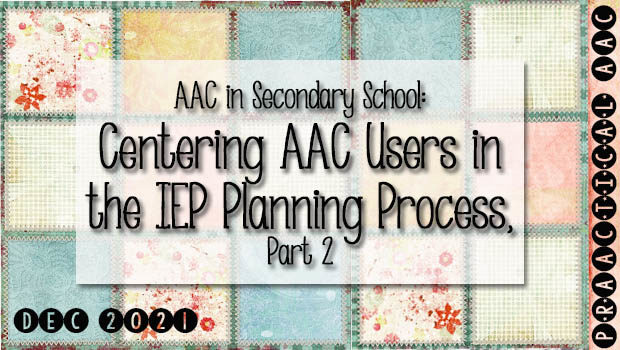
Students with disabilities rarely play an important role in developing and discussing the plan that guides their educational experiences, the IEP. That needs to change.
Today, we’re delighted to welcome back AAC SLP Ashley Larisey to continue an important discussion on this topic. Ashley Larisey, an SLP at Community High School District 218 in Oak Lawn, Illinois, discusses ways to support students who use AAC as they prepare to transition out of school in the AAC in Secondary School series. Ashley, who is also an Adjunct Clinical Supervisor and Instructor at Saint Xavier University, has some prAACtical suggestions that are important for school teams, students who use AAC, their families, and school administrators.
You can find Ashley’s first post on this topic here.
:::::::::::::::::::::::::::::::::::::::::::::::::::::::::::::::::::::::::::::::::::::::::::::::::::::::
Centering AAC Users in the IEP Planning Process
Part Two: Putting It into Action
Last month, we discussed different strategies for including AAC users in the IEP and transition planning process (for more information about strategies and resources to use in IEP planning, check out that post here). This month, we will provide examples of implementation of the previously discussed resources as well as case examples to highlight methods in which these tools can be implemented with learners in academic settings.
Let’s look at a few different examples of ways to involve AAC users in the IEP process. The following are two hypothetical case examples that highlight the various ways that AAC users can participate in the IEP planning process.
Case Example 1: Jailen
Jailen is a 14-year-old freshman who uses a dynamic display grid-based AAC system as well as text with word prediction to communicate with others. When assessed using the Dynamic AAC Goals Grid (DAGG-2), Jailen’s communication profile is best characterized as Transitional-Independent. Jailen has an interest in working with animals and enjoys playing video games online. He has expressed a strong desire for increased independence and opportunities to participate in activities within his community.
At the beginning of the school year, Jailen’s team completes the Communicator Preferences Inventory (RAST resources) with support from his case manager. This tool helps to support Jailen’s stakeholders in understanding his preferred interaction style. Jailen then co-constructs and programs self-advocacy statements that correspond to his preferences into his AAC system (e.g. “Please don’t guess what I am going to say and allow me to finish my message”, and “I prefer if you look at me and not my device when I speak. It helps me to see your face.”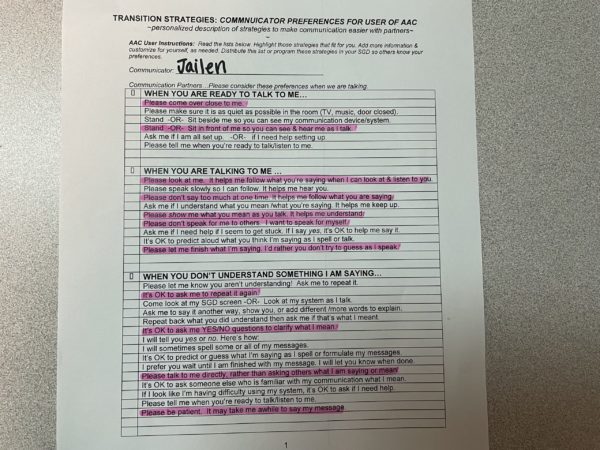
Jailen also completes the Framing a Future Tool (King, Lunger, & Toomey – The Bridge School ©2005) with support from his educational team and family. Areas of high importance but low/medium satisfaction were identified and included Developing Talents and Interests and Community Membership. Specifically, Jailen indicated that it was important to him to go to places within his community and be a member of a club, team, or group. Rankings of low/medium satisfaction indicate that Jailen desires fulfillment with these experiences but does not yet have opportunities to fully participate in them. Thankfully, many of these opportunities are present within his high school setting. This information can be used to drive IEP programming to best support Jailen’s future goals.
When preparing for the IEP, Jailen chooses to present at the IEP, highlighting his perceived areas of strength, interests, learning preferences, and interaction style. Jailen works in conjunction with his SLP to formulate and pre-program messages into his AAC system with the use of a graphic organizer, a printout of a blank page with his AAC system, and color-coding used to support organization of the major categories he will address.
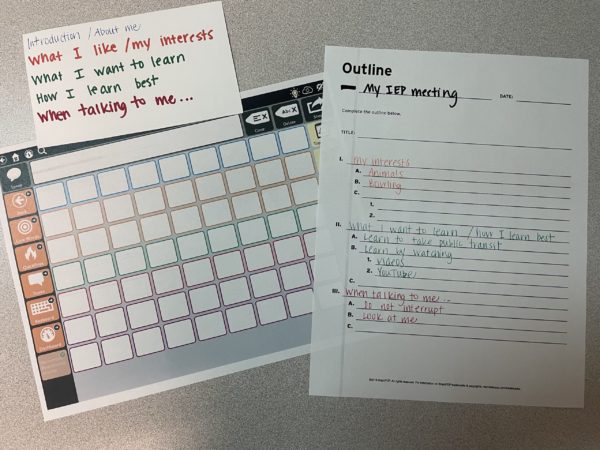
Case Example #2: Amani
Amani is a 19-year-old student in a post-secondary program that supports transition students until age 22. Amani communicates using partner-assisted scanning and a PODD communication book. When assessed using the Dynamic AAC Goals Grid (DAGG-2), her communication profile is characterized as emergent. Amani enjoys listening to music, watching videos, and creating art using adapted equipment.
Amani’s stakeholders have compiled a communication dictionary which is a collaborative, living document that is updated on an ongoing basis. This describes some of Amani’s observable behaviors and outlines what they may mean, as well as how communication partners should respond. Oftentimes, caregivers are the most knowledgeable and consistent team members over the lifetime of the IEP; therefore, involving them in the maintenance and sharing of this document ensures that all stakeholders understand Amani’s gestures and other methods of communication so that they can appropriately respond.
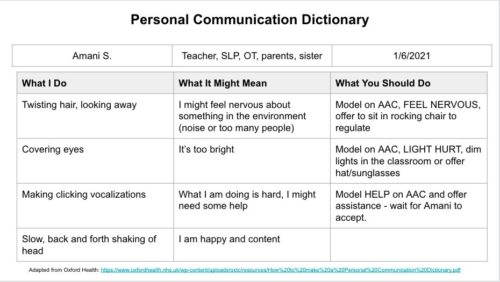
Amani’s preferences are assessed on an ongoing basis using rating scales. The ability to express likes/dislikes is a critical component of communication that is directly tied to transition and IEP planning for all students. Amani is provided with frequent opportunities to identify her preferences using multi-sensory activities. For example, Amani is provided with a topic (e.g. TV shows), watches video clips, and rates the TV shows using a like/ it’s okay / don’t like it rating scale. During times when Amani expresses an opinion using observable behaviors like smiling or turning her head away, her staff will use verbal referencing to state what they see, and then attribute meaning to the behavior using symbolic language (via the AAC system or visual icons). For example, Amani smiled and rocked her body while watching a video clip, but when asked her preference using an open-ended question, did not provide a response. After providing ample wait time, her staff member stated, “I saw you were smiling when watching, it looks like you LIKE it” (modeling “LIKE” using symbols within the rating scale). 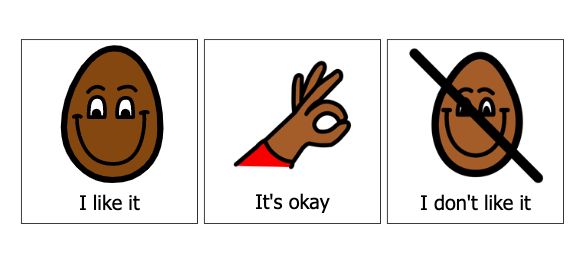
Amani also completes rating scales following vocational and community activities. She takes photos on her iPad to document the experiences, rates activities within those experiences and compiles these into an educational portfolio which will leave with her after she ages out of special education services. Her rating scales are used to guide her educational team in providing her with opportunities that are preferred and meaningful. With ample exposure and use of the consistent rating scale, Amani then participates in a visually supported transition questionnaire which is updated annually to monitor changes to her preferences.
Amani uses the photos that she has compiled from her daily activities to co-construct a slideshow with support from her educational team. Amani has already indicated her preferences using the rating scale, which is then used to present her portion of the IEP to share her own ideas. Because Amani uses a picture communication book that does not provide voice output, Amani uses a sequential voice output communication device that is pre-programmed with messages that highlight some of her daily experiences as well as the preferences she identified. Her SLP uses co-planned sequenced social scripts (Musselwhite, Burkhart) to provide information on each slide while Amani chooses certain words to include, listed below in BOLD. Below is an example of the co-planned social script for a restaurant experience as a sample slide for her presentation.
- “Alright, here’s what’s next.”
- “This is when we went to Blues Fest.”
- “You’re never going to believe what I ate.”
“Go ahead and take a guess.” - “I ate OCTOPUS.”
- “Isn’t that SCARY?”
- “I LIKE trying new foods.”
- “I LIKE listening to music.”
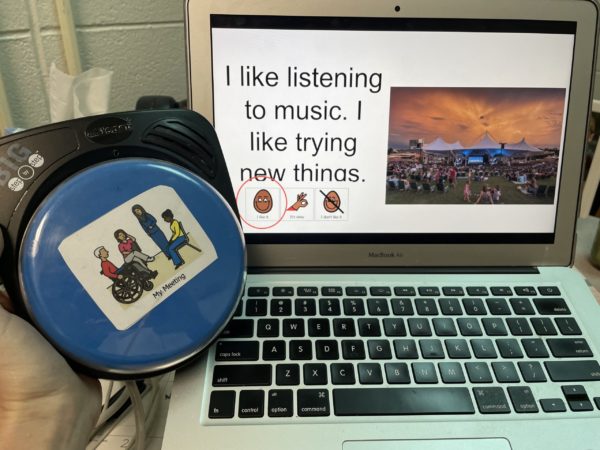
As always, check in with the learner by asking things like “Does that sound right?” or “Is there anything you want to change?” This helps to honor the individuality of the message while still providing an opportunity to engage in a rich back-and-forth social exchange during her IEP. All stakeholders appreciate Amani’s contributions to the IEP and learn something new about her preferences and life experiences. This helps to strengthen relationships and facilitate shared understanding.
No matter where the individual is on their journey towards communicative competence, we can provide opportunities to ensure that their planning is person-centered and that they have an active seat at the table when planning their future.
Filed under: Featured Posts, PrAACtical Thinking
This post was written by Carole Zangari
